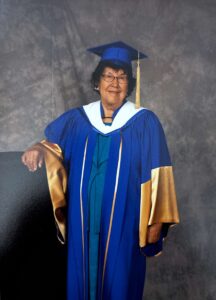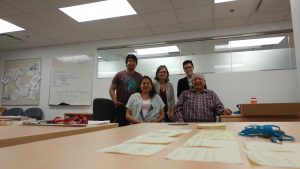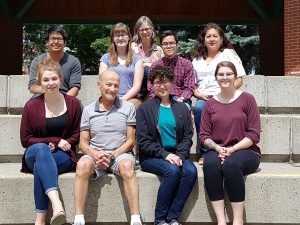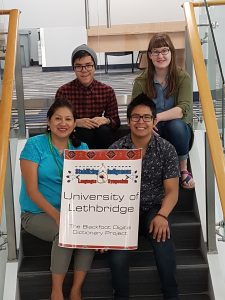Do you want to learn Niitsi’powahsin, the language of our territory? In the Winter 2025 semester we are offering four different Blackfoot language courses. There’s something for everyone, from total beginners to advanced intermediate speakers. BKFT1000, 2000 and 3850 are taught in Lethbridge at the Iniskim (University of Lethbridge) campus. BKFT2210 is taught entirely online in asynchronous format so can be taken by anyone no matter where you are located. Current students can find more information on the dynamic schedule. For general registration information including for audit students go to the Registrar’s website.

 We are so very sad at the passing of Ikkináínihki (Gentle Singer) Dr. Lena Heavy Shields Russell (BEd ’77, LLD ’06) on March 29, 2024.
We are so very sad at the passing of Ikkináínihki (Gentle Singer) Dr. Lena Heavy Shields Russell (BEd ’77, LLD ’06) on March 29, 2024.
Lena spent her entire working life promoting and teaching Niitsi’powahsin, the Blackfoot language. She taught in the public schools on and off reserve as well as at Iniskim University of Lethbridge, where she taught Advanced Spoken Blackfoot courses in the early 2000s. To support Blackfoot language teaching in the schools, Ikkináínihki published a series of textbooks for the middle and high school level that remains one of the most comprehensive teaching resources available. Dr. Heavy Shields Russell collaborated extensively on language-related projects. She was one of the principal consultants of the Blackfoot Dictionary of Stems, Roots and Affixes, co-edited by the late Donald Frantz with Lena’s daughter Norma Russell. Frantz also acknowledges her important contribution to his understanding of the language in his Blackfoot Grammar. In 2014 she published Ákaitsinikssiistsi: Blackfoot Stories of Old. Her various publications are listed on our Resources page.
Dr. Heavy Shields Russell was rightfully proud of her accomplishments. Her important work was recognized by an Honorary Doctorate of the University of Lethbridge in 2006. In 2018 she received the Esquao Lifetime Achievement Award from the Institute for the Advancement of Aboriginal Women (IAAW). In 2021 she was inducted into the Alberta Order of Excellence.
We are grateful and proud to have known Ikkináínihki and thankful for her long life and the professional and personal impact she has had on so many people.
A full obituary can be viewed here.
A condolence notice from the University of Lethbridge can be found here.
The first 8 lessons of our Blackfoot Grammar course are now available on the Blackfoot Language Resources YouTube channel. Let us know what you think of it!
Dominik Kadlec finished his MA thesis in Indigenous Studies at Iniskim University of Lethbridge with a thesis titled A computational model of Blackfoot noun and verb morphology. In this thesis he describes the work he did over the past two years developing a computational model of Blackfoot grammar. The thesis is now available through the University’s digital repository via this permanent link: https://hdl.handle.net/10133/6635.
Abstract: This thesis describes the construction of a computational model of Blackfoot word structure. This model was developed so that it could provide a foundation for Blackfoot language technologies such as spelling and grammar checkers, search suggestion generators, paradigm generators for pedagogical purposes, intelligent dictionaries, automated corpus parsers for linguistic research and more. Many Indigenous languages in Canada have been declining in use. In response, many Indigenous communities and activists have implemented revitalization strategies which vary in effectiveness. One way to help language efforts to be more effective is to ensure that tools for research and revitalization are freely available to community members. In the 21st century this can be achieved in part through technology, particularly with the help of the internet, which offers information freely (in most cases) to those who wish to access it. In this thesis I describe the early developments of a project that will be used to augment currently available digital resources and provide a basis for future technology for the Blackfoot language. I use Finite State Transducer technology to develop a computational model of Blackfoot noun and verb morphology and test the model using a corpus of modern Blackfoot text that was constructed from a curated collection of available texts.
We now have our own Blackfoot Language Resources YouTube channel! We just posted two short videos explaining the Blackfoot vowel and consonant sounds and how they are written in the standard spelling system.

Oki! Today we worked very hard with Beverly Hungry Wolf. We recorded words, short sentences, and some procedural texts and recipes. The team now has to process the audio files and then we hope to have them up on our dictionary and story archive soon. For an example of a phrase we recorded last week look up the verb say in the dictionary, and check out the example Tsá niitáíítsitapiáánio’pa? (“How do you say it in Blackfoot?”).

Today Francis First Charger came to visit our lab to provide some much-needed encouragement and guidance. Francis is one of the resident elders at the University of Lethbridge, and was able to make some time to come downtown to see our lab, even though he is a very busy man! We were very grateful for his prayers and support. Our work is sometimes tough and has some difficult moments and things that we have to work through. We have become a good team over the last little while and the team members really support and help each other with anything that’s needed. It was very good to have some advice and encouragement from Francis today.

This year we are again lucky to have a large number of people helping with the Blackfoot Language Resources website. Front row L-R: Brittany Wichers, Don Frantz, Natalie Weber, Shelby Johnson. Middle row L-R: Blaise Russell, Mahaliah Peddle, Inge Genee, Myles Shirakawa, Rachel Hoof. Not pictured: Amanda Thom and Dan O’Donnell. We took this picture on a beautiful afternoon in the Galt Gardens park in Lethbridge.

Oki! Last year’s wonderful team did an enormous amount of work on our Blackfoot Digital Dictionary and Blackfoot Language Resources website and also for the Algonquian Linguistic Atlas. This year’s team promises to be just as wonderful. Working hard are SSHRC summer students Myles Shirakawa and Mahaliah Peddle and STEP summer students Blaise Russell and Rachel Hoof. Their first tasks are to process all the material that was collected by last year’s team and never made its way onto the website yet. New audio files and images are being added daily to the dictionary. Check out the word for airplane: áípottaa for a cool example!
Welcome to the Blackfoot Digital Dictionary project. You can find our dictionary at http://dictionary.blackfoot.atlas-ling.ca. Send comments to inge.genee@uleth.ca.
This is very much a work in progress. It changes every day as we continue to make updates, corrections and addition. It is now May 8 2017 and we are getting ready to do some more work on it this summer. The first research assistant who is starting this year is Mahaliah Peddle. Welcome Mahaliah!
